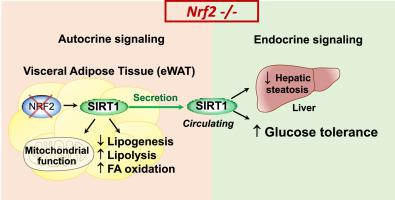Redox Biology ( IF 10.7 ) Pub Date : 2020-11-24 , DOI: 10.1016/j.redox.2020.101805 Laura Braud 1 , Maria Pini 1 , Donald F Stec 2 , Sylvie Manin 1 , Geneviève Derumeaux 1 , David E Stec 3 , Roberta Foresti 1 , Roberto Motterlini 1

|
Obesity is associated with metabolic dysregulation characterized by insulin resistance and glucose intolerance. Nuclear factor E2-related factor (Nrf2) is a critical regulator of the stress response and Nrf2-deficient mice (Nrf2−/−) are protected against high fat diet (HFD)-induced metabolic derangement. We searched for factors that could underline this favorable phenotype and found that Nrf2−/− mice exhibit higher circulating levels of sirtuin 1 (Sirt1), a key player in cellular homeostasis and energy metabolism, compared to wild-type mice. Increased Sirt1 levels in Nrf2−/− mice were found not only in animals under standard diet but also following HFD. Interestingly, we report here that the visceral adipose tissue (eWAT) is the sole source of increased Sirt1 protein in plasma. eWAT and other fat depots displayed enhanced adipocytes lipolysis, increased fatty acid oxidation and glycolysis, suggesting autocrine and endocrine actions of Sirt1 in this model. We further demonstrate that removal of eWAT completely abolishes the increase in circulating Sirt1 and that this procedure suppresses the beneficial effect of Nrf2 deficiency on glucose tolerance, but not insulin sensitivity, following a HFD regime. Thus, in contrast to many other stressful conditions where Nrf2 deficiency exacerbates damage, our study indicates that up-regulation of Sirt1 levels specifically in the visceral adipose tissue of Nrf2−/− mice is a key adaptive mechanism that mitigates glucose intolerance induced by nutritional stress.
中文翻译:

内脏白色脂肪组织分泌的 Sirt1 增加与肥胖 Nrf2 缺陷小鼠的葡萄糖耐量改善相关
肥胖与以胰岛素抵抗和葡萄糖不耐受为特征的代谢失调有关。核因子 E2 相关因子 (Nrf2) 是应激反应的关键调节因子,Nrf2 缺陷小鼠 (Nrf2 −/− ) 可以免受高脂肪饮食 (HFD) 诱导的代谢紊乱。我们寻找可能强调这种有利表型的因素,发现与野生型小鼠相比,Nrf2 −/−小鼠表现出更高的 Sirtuin 1 (Sirt1) 循环水平,Sirt1 是细胞稳态和能量代谢的关键参与者。 Nrf2 -/−小鼠中 Sirt1 水平的增加不仅在标准饮食下的动物中发现,而且在 HFD 后的动物中也发现。有趣的是,我们在此报告内脏脂肪组织 (eWAT) 是血浆中 Sirt1 蛋白增加的唯一来源。 eWAT 和其他脂肪库表现出脂肪细胞脂肪分解增强、脂肪酸氧化和糖酵解增加,表明 Sirt1 在此模型中具有自分泌和内分泌作用。我们进一步证明,去除 eWAT 完全消除了循环 Sirt1 的增加,并且该过程抑制了 HFD 方案后 Nrf2 缺乏对葡萄糖耐量的有益影响,但不抑制胰岛素敏感性。因此,与 Nrf2 缺乏加剧损害的许多其他应激条件相比,我们的研究表明,Nrf2 −/−小鼠内脏脂肪组织中 Sirt1 水平的上调是减轻营养应激引起的葡萄糖不耐受的关键适应性机制。











































 京公网安备 11010802027423号
京公网安备 11010802027423号